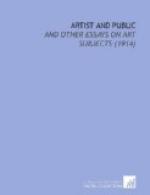But it is not only in mural decoration that serious figure-painting is being done in this country. I do not see how any one can deny the name of pictures to the genre paintings of Mr. Tarbell and Mr. Paxton unless he is prepared to deny pictorial quality to the whole Dutch school of the seventeenth century; and the example of these men is influencing a number of others toward the production of thoroughly thought-out and executed genre pictures. We have long had such serious figure-painters as Thayer and Brush, Dewing and Weir. The late Louis Loeb was attempting figure subjects of a very elaborate sort. To-day every exhibition shows an increasing number of worthy efforts at figure-painting in either the naturalistic or the ideal vein. We have pictures with subjects intelligently chosen and intelligibly treated, pictures with a pattern and a clear arrangement of line and mass, pictures soundly drawn and harmoniously colored as well as admirably painted.
The painters of America are no longer followers of foreign masters or students learning technic and indifferent to anything else. They are a school producing work differing in character from that of other schools and at least equal in quality to that of any school existing to-day.
If so much may be taken as proved, the question remains for consideration: What are the characteristics of the American school of painting? Its most striking characteristic is one that may be considered a fault or a virtue according to the point of view and the prepossessions of the observer. It is a characteristic that has certainly been a cause of the relatively small success of American work at recent international exhibitions. The American school is, among the schools of to-day, singularly old-fashioned. This characteristic has, undoubtedly, puzzled and repelled the foreigner. It is a time when the madness for novelty seems to be carrying everything before it, when anything may be accepted so long as it is or seems new, when the effort of all artists is to get rid of conventions and to shake off the




